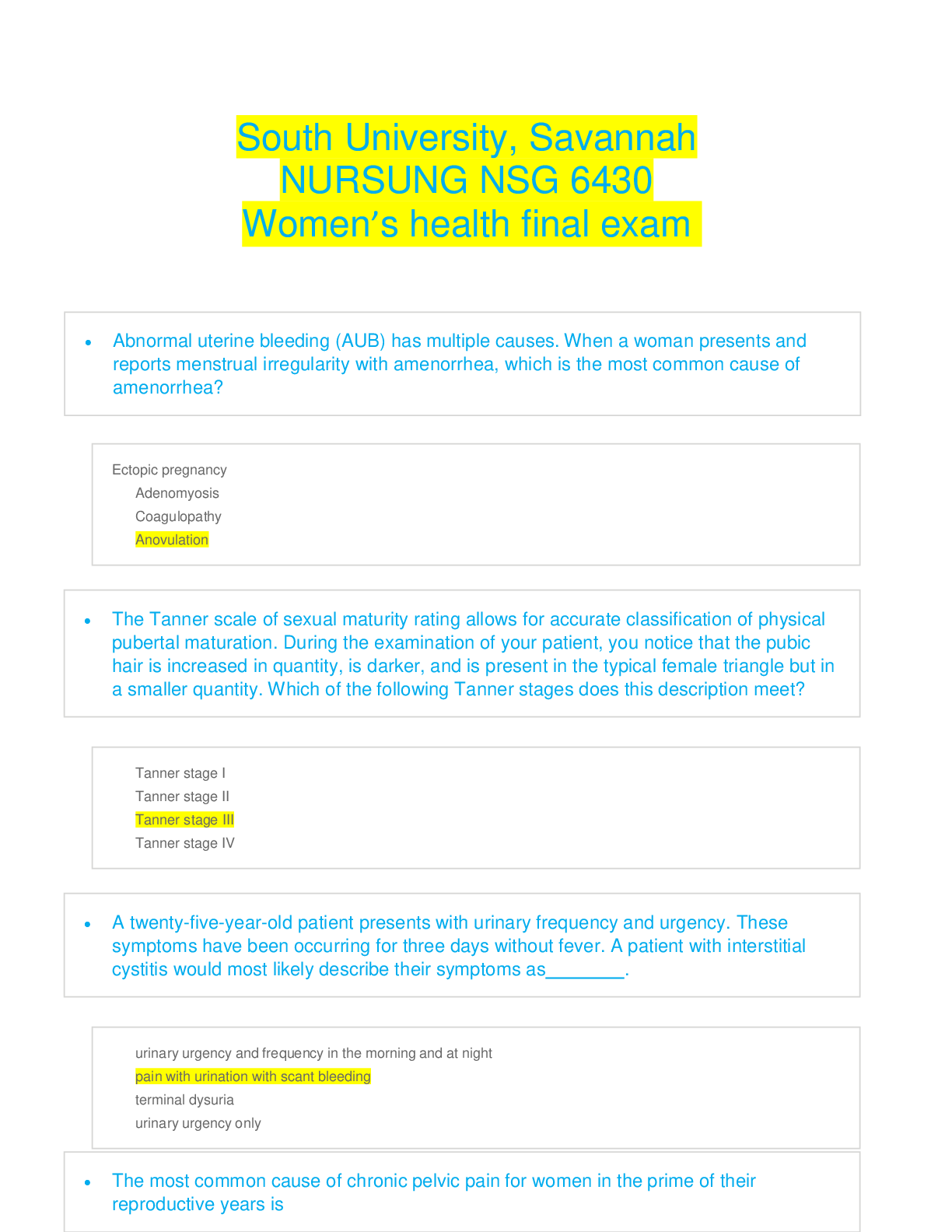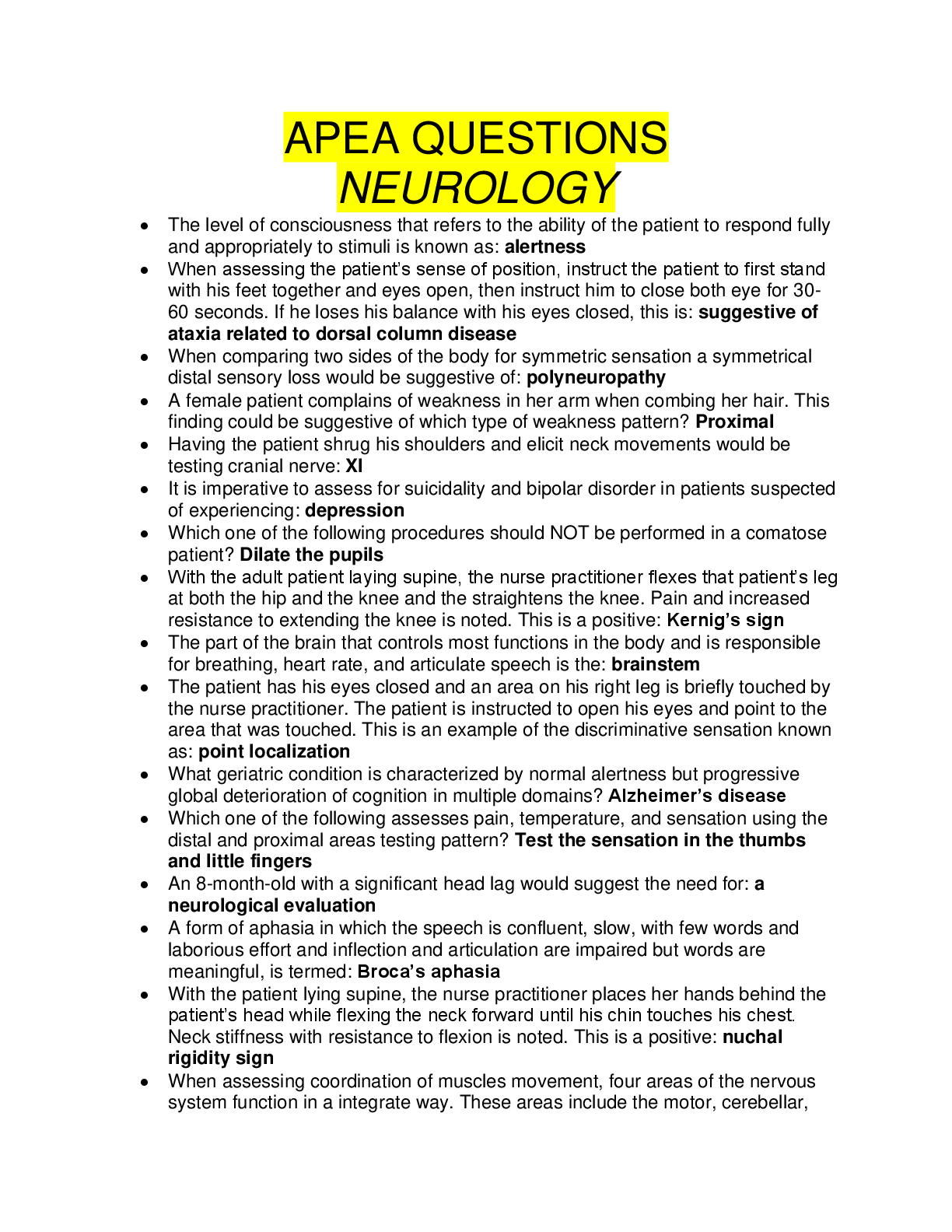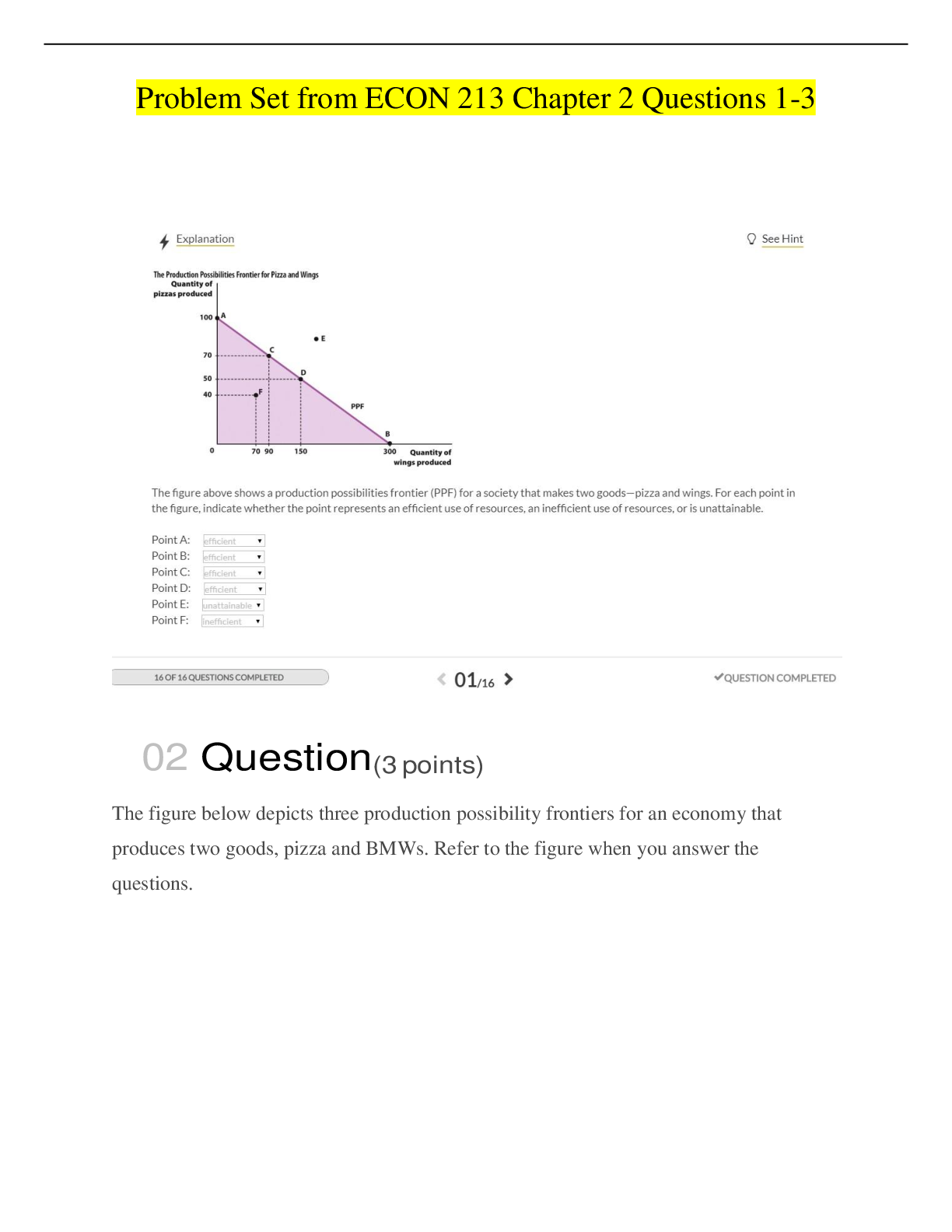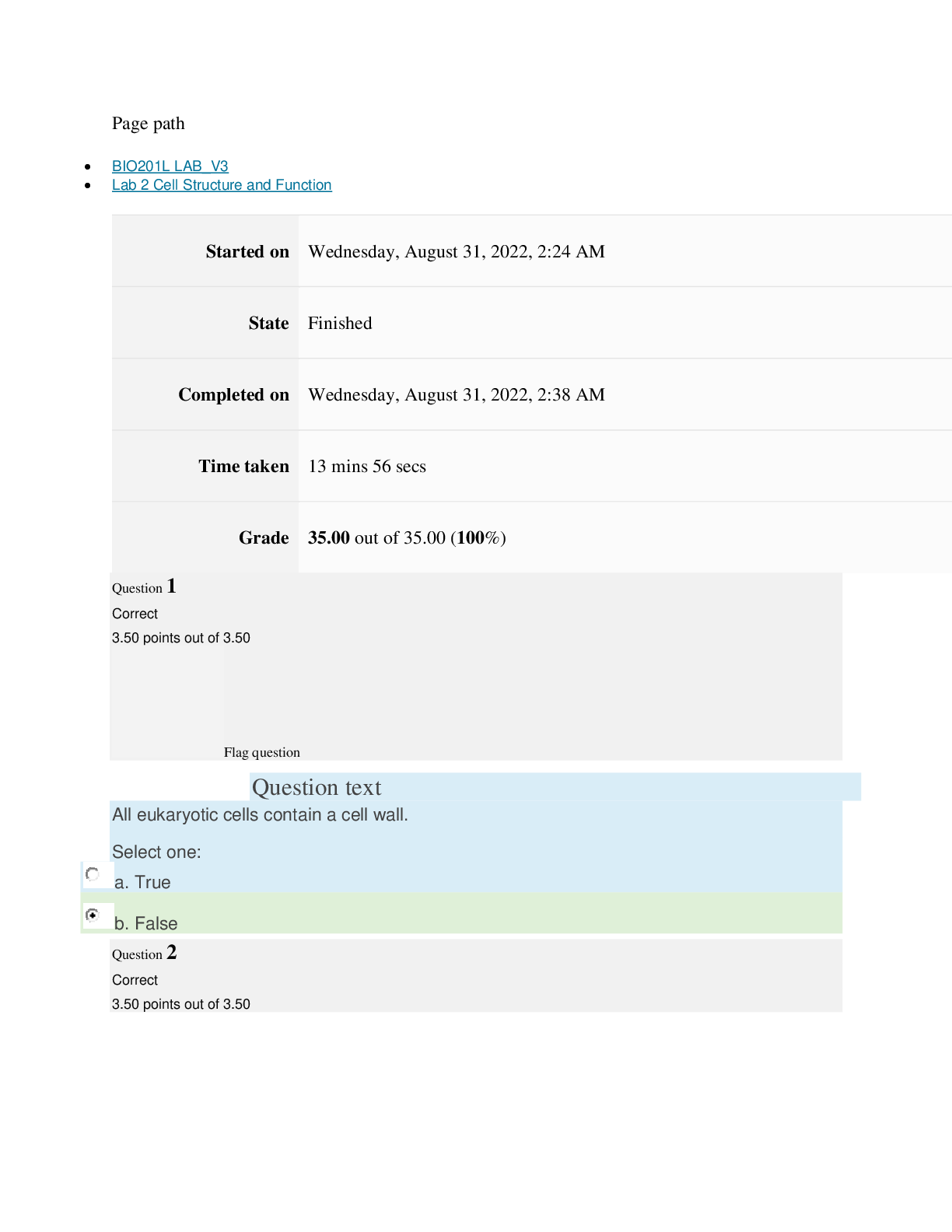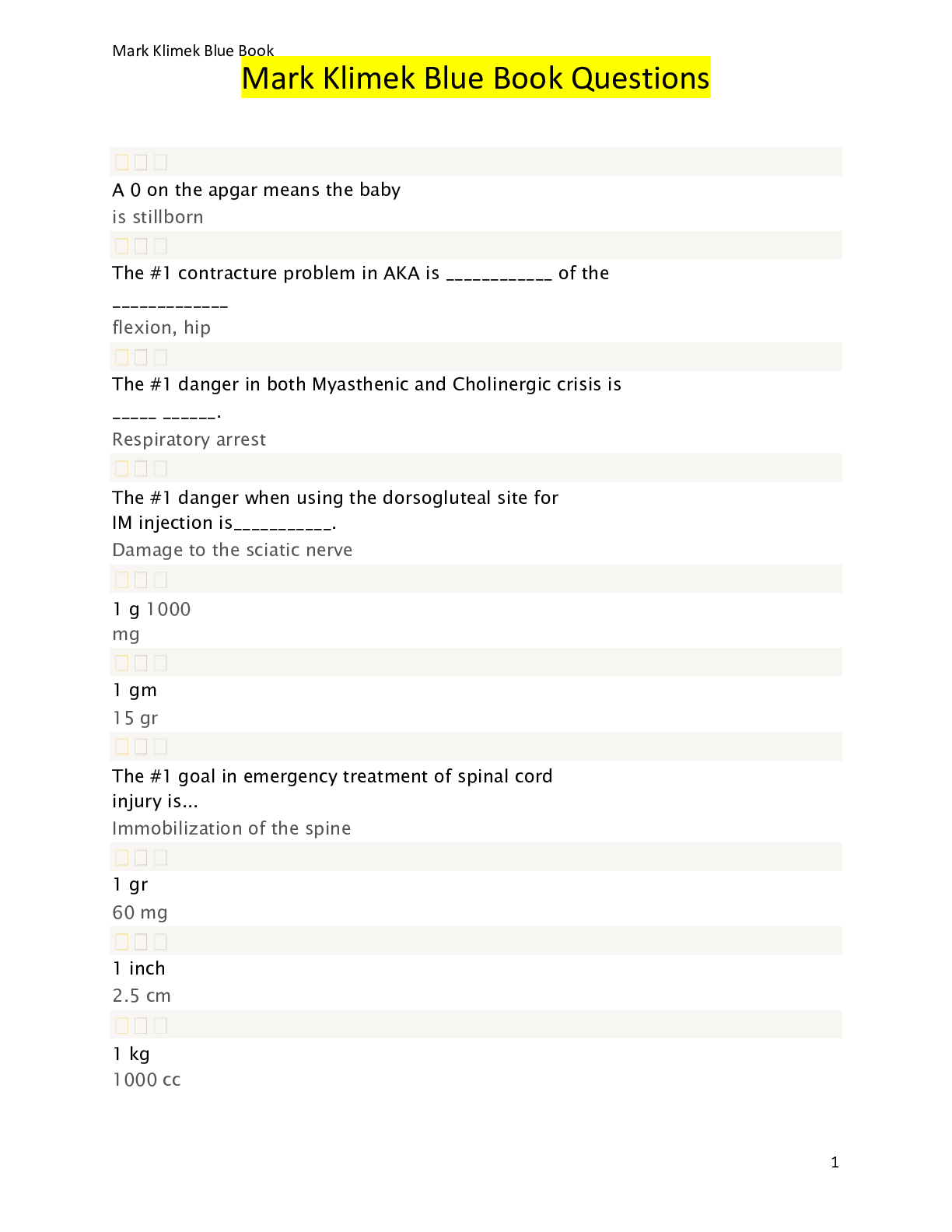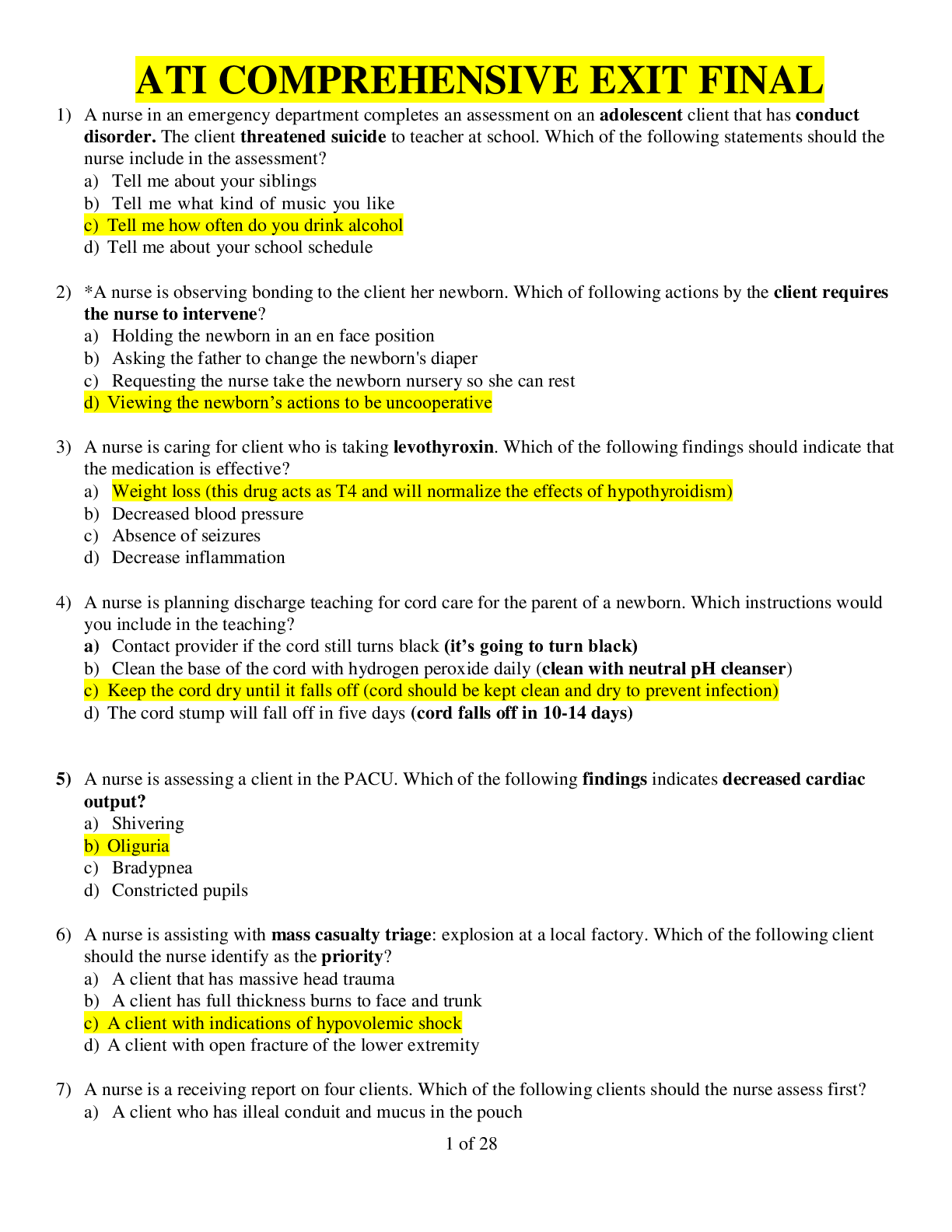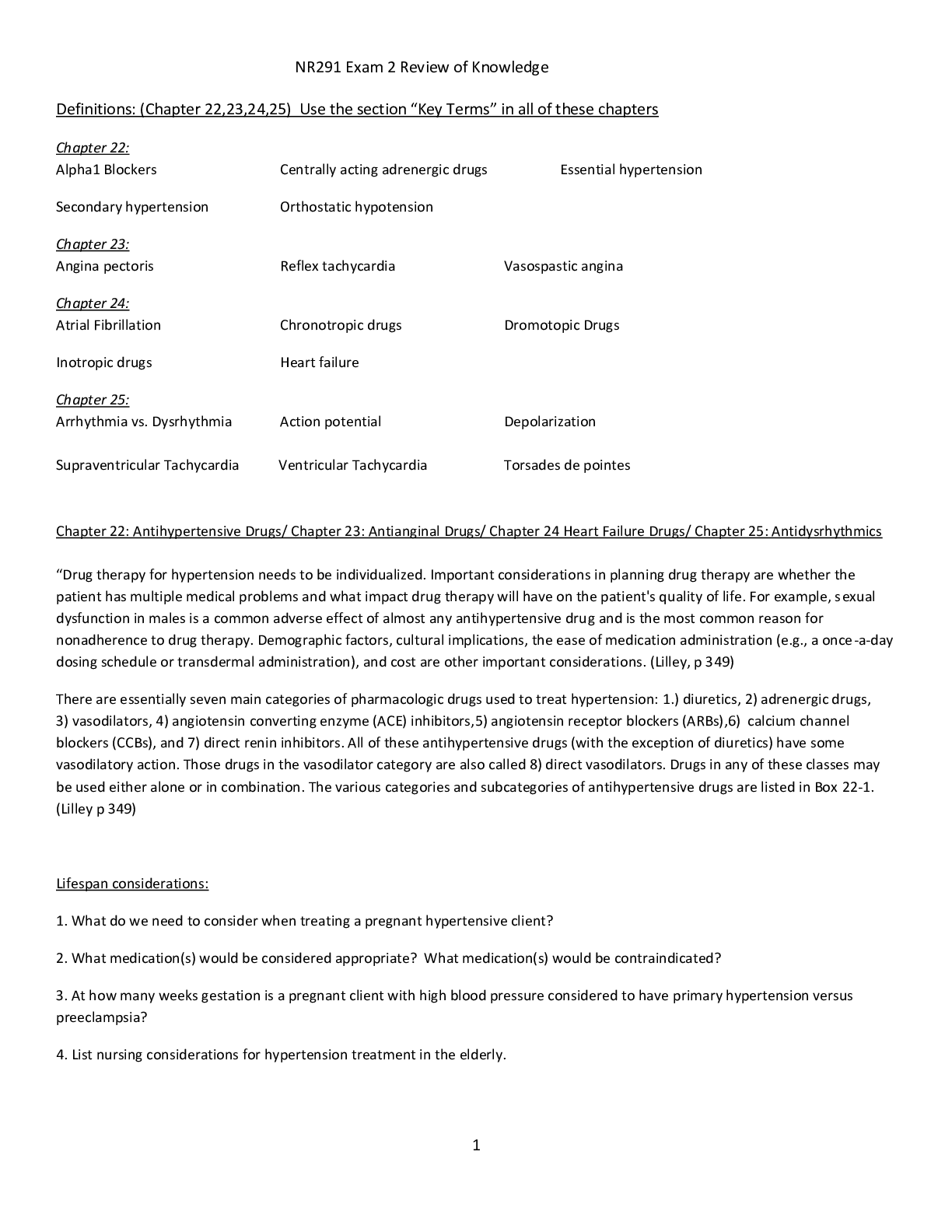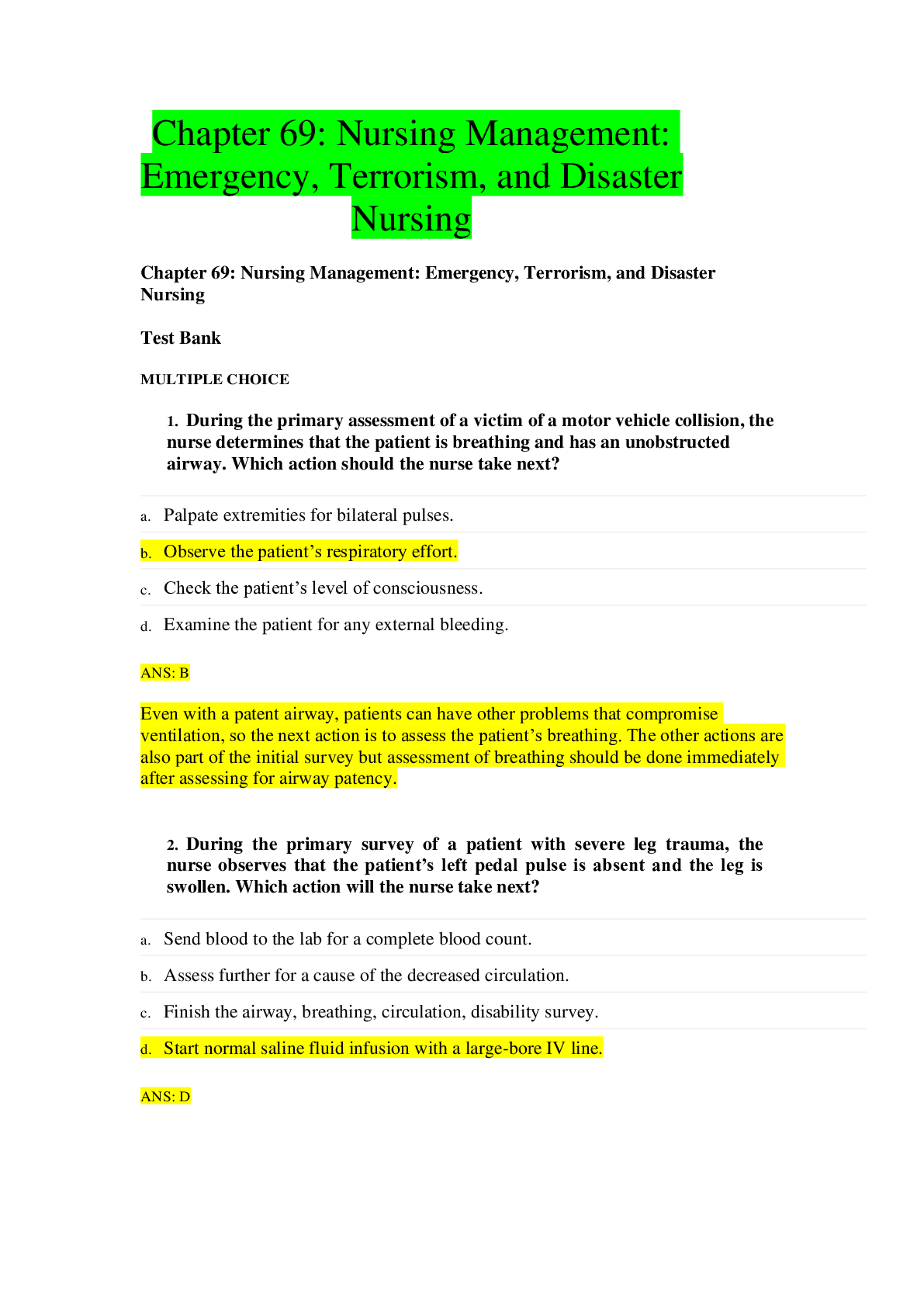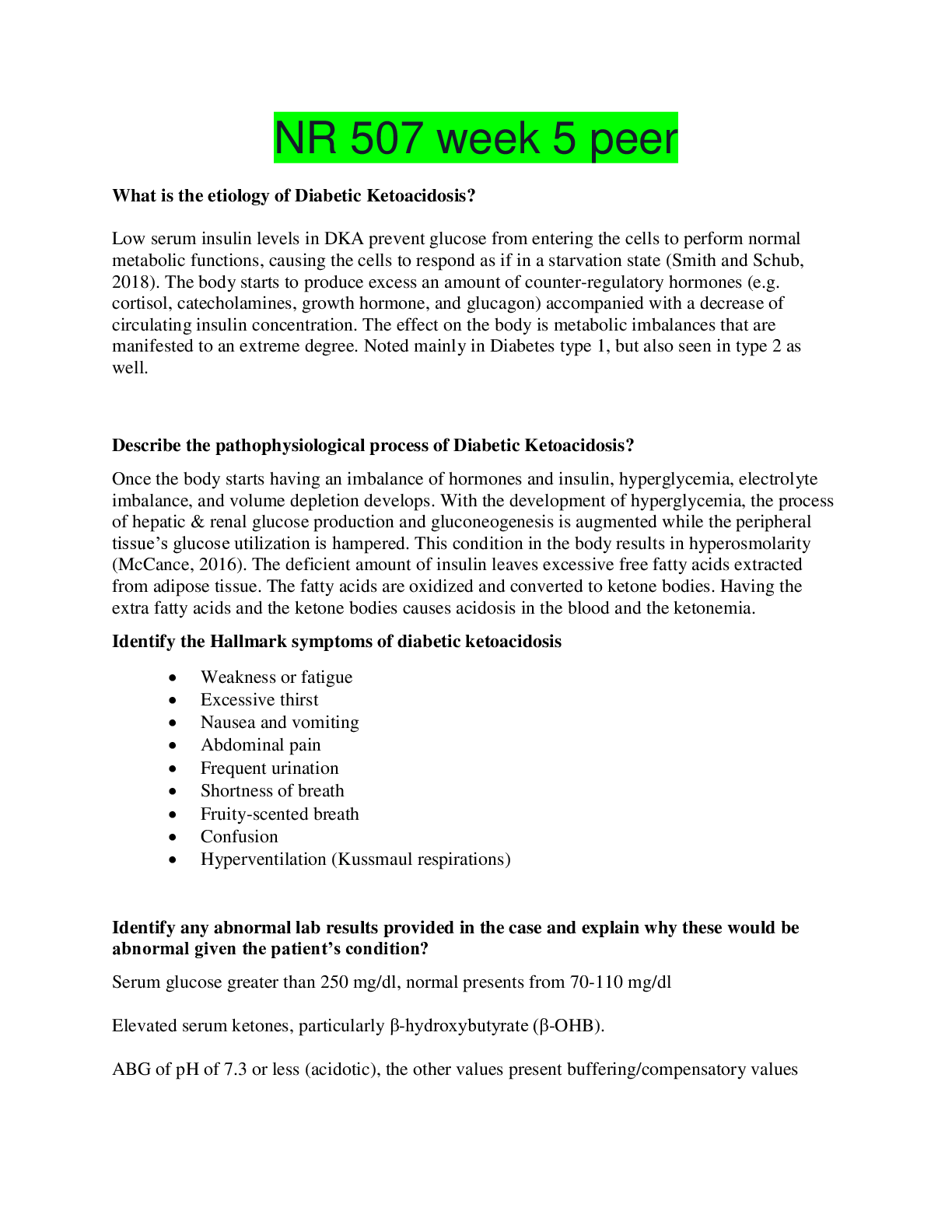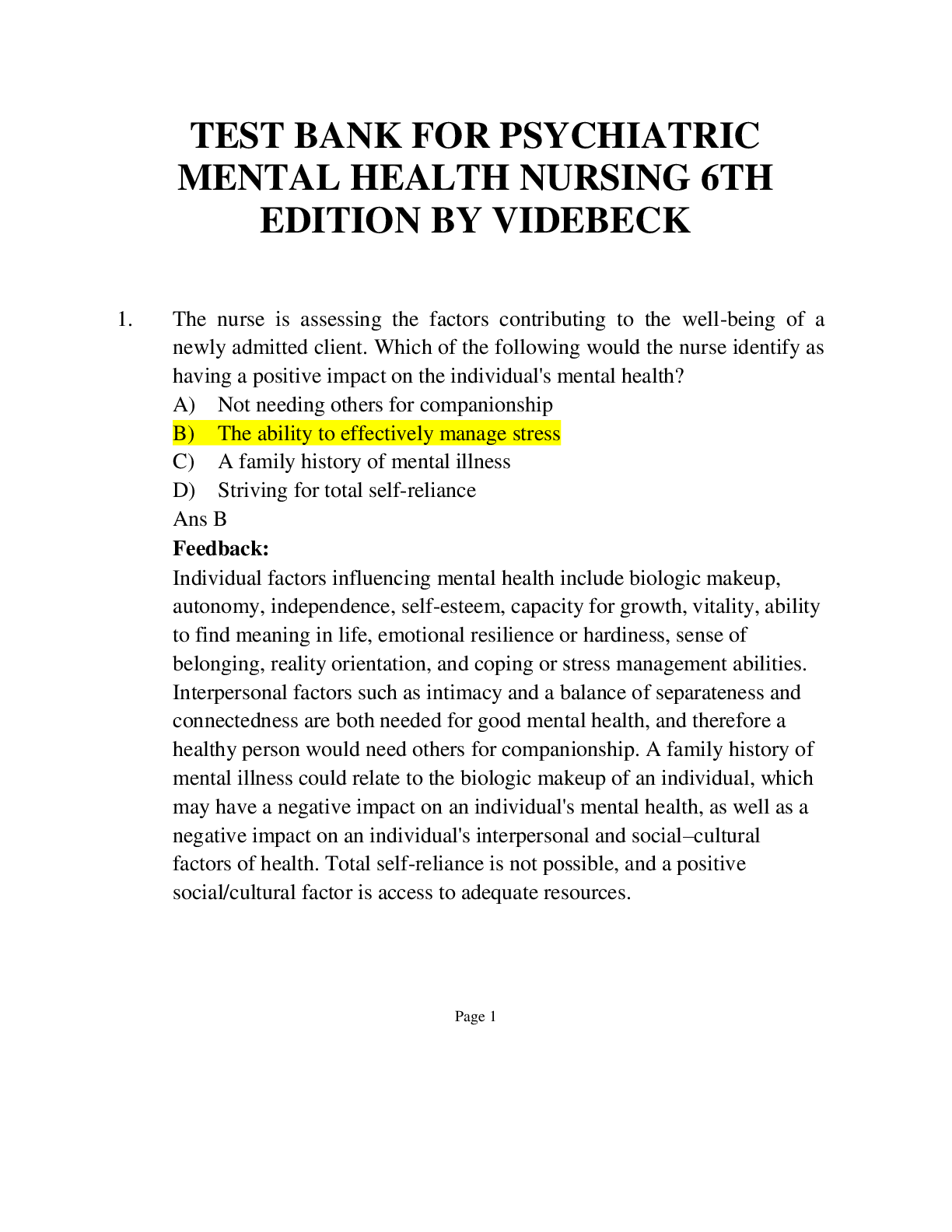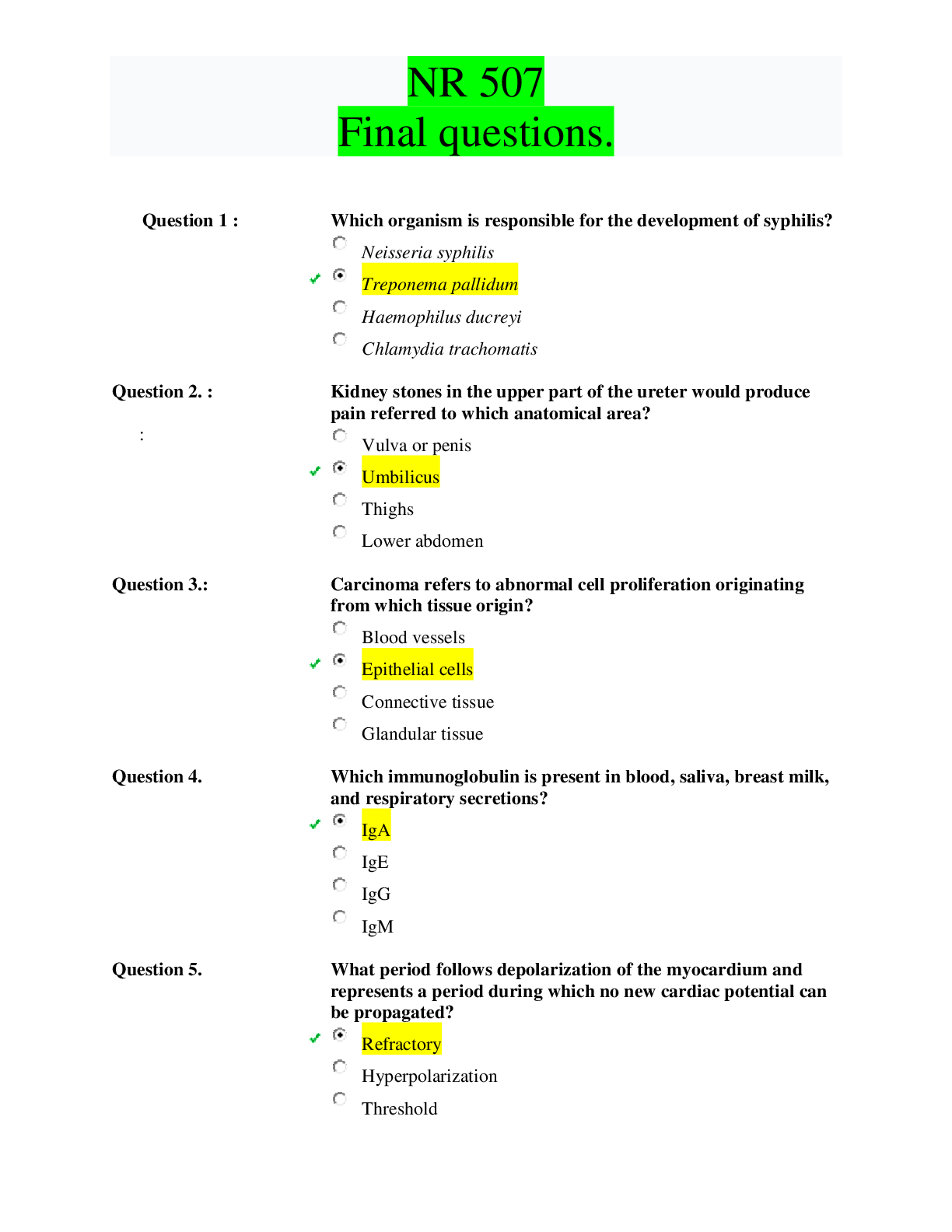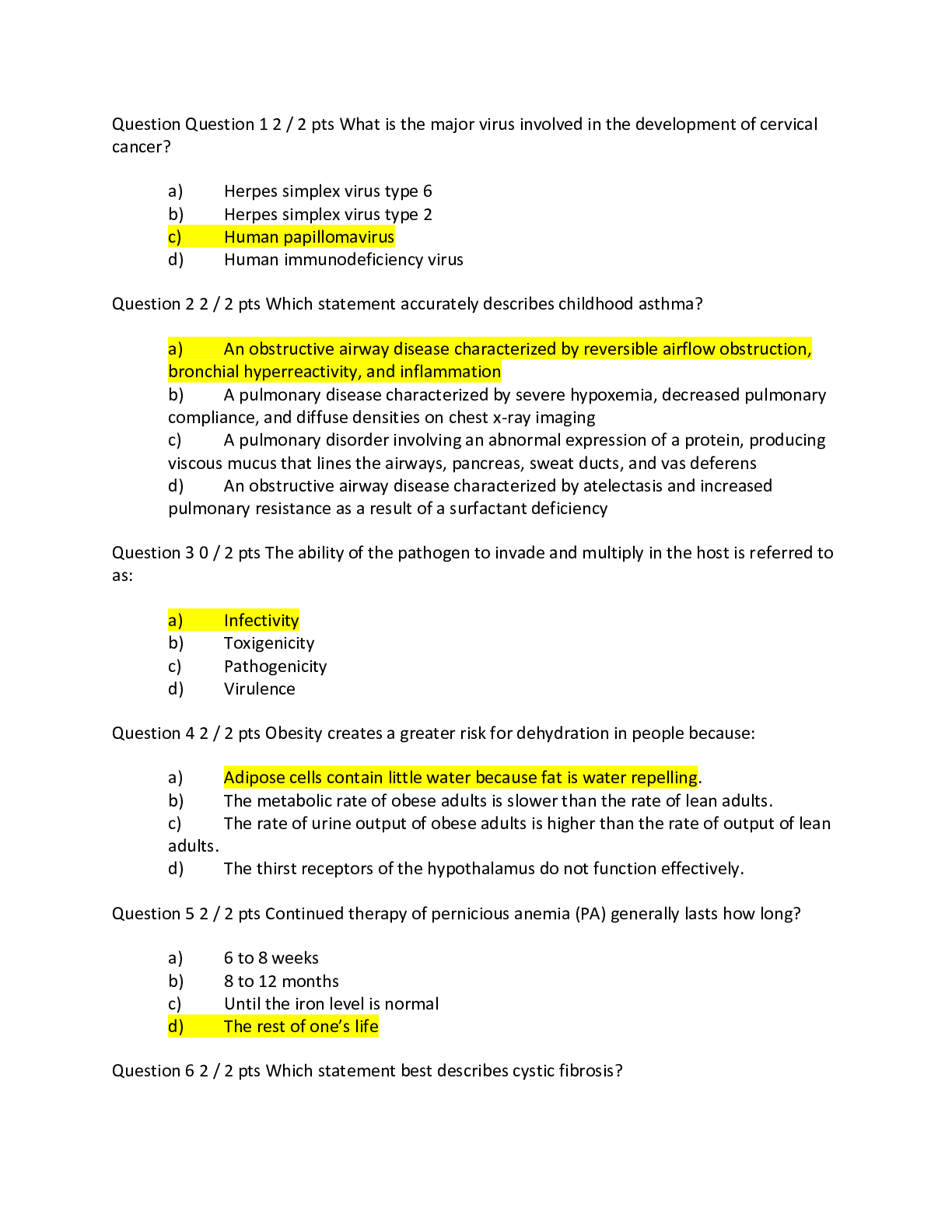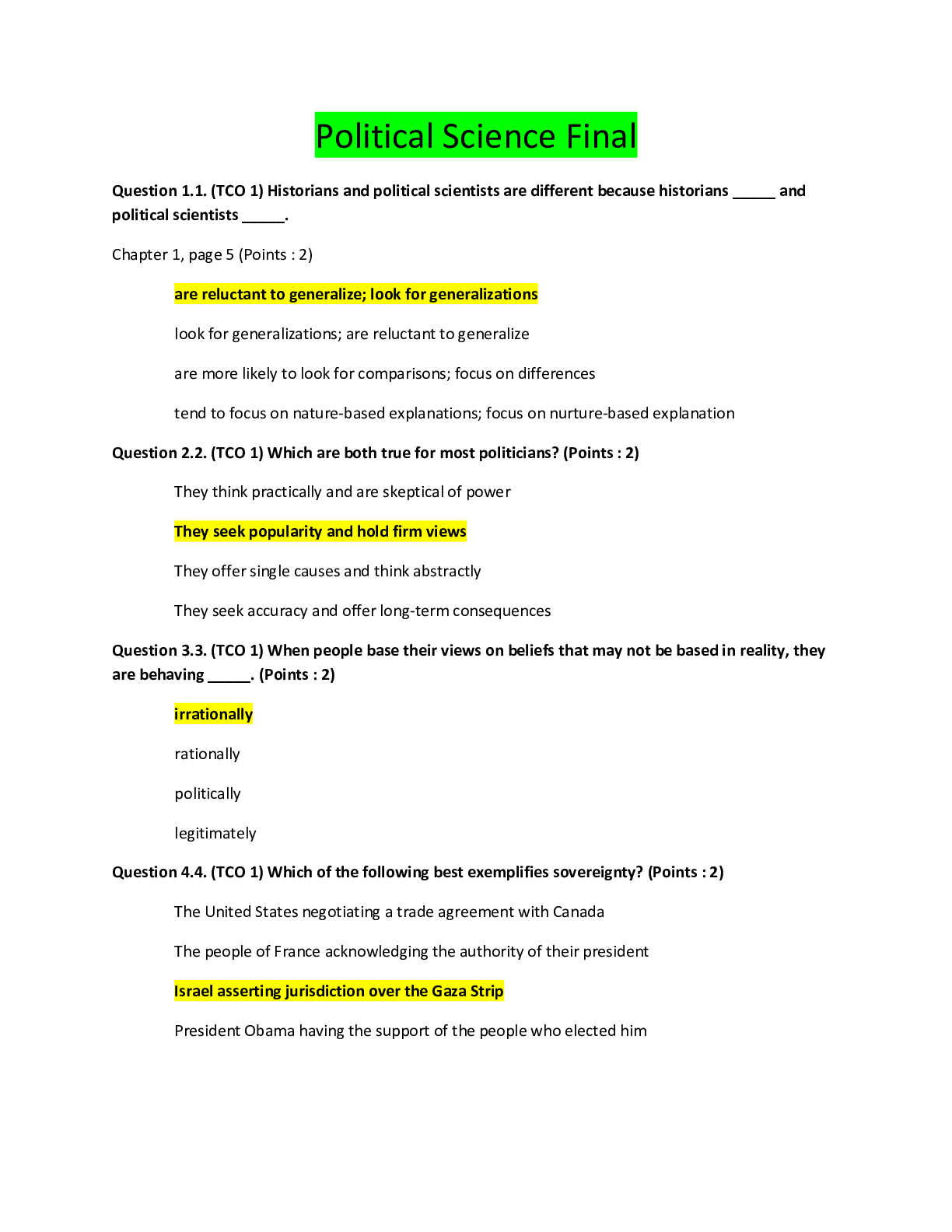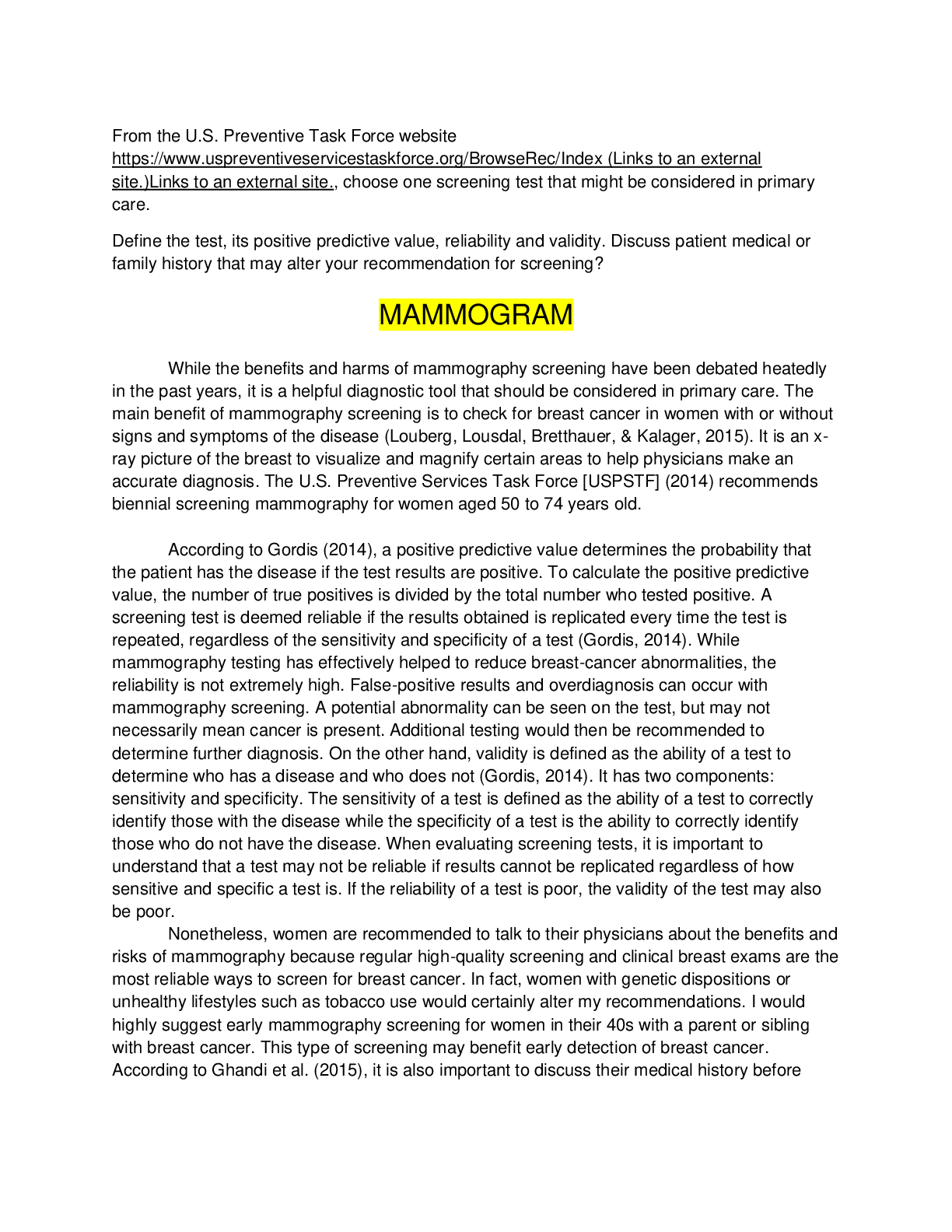*NURSING > QUESTIONS & ANSWERS > Chamberlain College Of Nursing > NURSING 324. NR 324. Chapter 66 Nursing Management: Critical Care (All)
Chamberlain College Of Nursing > NURSING 324. NR 324. Chapter 66 Nursing Management: Critical Care
Document Content and Description Below
Chapter 66: Nursing Management: Critical Care Chapter 66: Nursing Management: Critical Care Test Bank MULTIPLE CHOICE 1. A 68-year-old patient has been in the intensive care unit for 4 days and ... has a nursing diagnosis of disturbed sensory perception related to sleep deprivation. Which action should the nurse include in the plan of care? a. Administer prescribed sedatives or opioids at bedtime to promote sleep. b. Cluster nursing activities so that the patient has uninterrupted rest periods. c. Silence the alarms on the cardiac monitors to allow 30- to 40-minute naps. d. Eliminate assessments between 0100 and 0600 to allow uninterrupted sleep. 2. Which hemodynamic parameter is most appropriate for the nurse to monitor to determine the effectiveness of medications given to a patient to reduce left ventricular afterload? a. Mean arterial pressure (MAP) b. Systemic vascular resistance (SVR) c. Pulmonary vascular resistance (PVR) d. Pulmonary artery wedge pressure (PAWP) 3. While family members are visiting, a patient has a respiratory arrest and is being resuscitated. Which action by the nurse is best? a. Tell the family members that watching the resuscitation will be very stressful. b. Ask family members if they wish to remain in the room during the resuscitation. c. Take the family members quickly out of the patient room and remain with them. d. Assign a staff member to wait with family members just outside the patient room. 4. Following surgery for an abdominal aortic aneurysm, a patient’s central venous pressure (CVP) monitor indicates low pressures. Which action is a priority for the nurse to take? a. Administer IV diuretic medications. b. Increase the IV fluid infusion per protocol. c. Document the CVP and continue to monitor. d. Elevate the head of the patient’s bed to 45 degrees. When caring for a patient with pulmonary hypertension, which parameter is most appropriate for the nurse to monitor to evaluate the effectiveness of the treatment? a. Central venous pressure (CVP) b. Systemic vascular resistance (SVR) c. Pulmonary vascular resistance (PVR) d. Pulmonary artery wedge pressure (PAWP) 5. The intensive care unit (ICU) nurse educator will determine that teaching about arterial pressure monitoring for a new staff nurse has been effective when the nurse a. balances and calibrates the monitoring equipment every 2 hours. b. positions the zero-reference stopcock line level with the phlebostatic axis. c. ensures that the patient is supine with the head of the bed flat for all readings. d. rechecks the location of the phlebostatic axis when changing the patient’s position. 6. When monitoring for the effectiveness of treatment for a patient with a large anterior wall myocardial infarction, the most important information for the nurse to obtain is a. central venous pressure (CVP). b. systemic vascular resistance (SVR). c. pulmonary vascular resistance (PVR). d. pulmonary artery wedge pressure (PAWP). 7. Which action is a priority for the nurse to take when the low pressure alarm sounds for a patient who has an arterial line in the left radial artery? a. Fast flush the arterial line. b. Check the left hand for pallor. c. Assess for cardiac dysrhythmias. d. Rezero the monitoring equipment. 8. Which action will the nurse need to do when preparing to assist with the insertion of a pulmonary artery catheter? a. Determine if the cardiac troponin level is elevated. b. Auscultate heart and breath sounds during insertion. c. Place the patient on NPO status before the procedure. d. Attach cardiac monitoring leads before the procedure. 9. When assisting with the placement of a pulmonary artery (PA) catheter, the nurse notes that the catheter is correctly placed when the monitor shows a a. typical PA pressure waveform. b. tracing of the systemic arterial pressure. c. tracing of the systemic vascular resistance. d. typical PA wedge pressure (PAWP) tracing. 10. Which assessment finding obtained by the nurse when caring for a patient with a right radial arterial line indicates a need for the nurse to take immediate action? a. The right hand is cooler than the left hand. b. The mean arterial pressure (MAP) is 77 mm Hg. c. The system is delivering 3 mL of flush solution per hour. d. The flush bag and tubing were last changed 3 days previously. 11. The central venous oxygen saturation (ScvO2) is decreasing in a patient who has severe pancreatitis. To determine the possible cause of the decreased ScvO2, the nurse assesses the patient’s a. lipase. b. temperature. c. urinary output. d. body mass index. 12. An intraaortic balloon pump (IABP) is being used for a patient who is in cardiogenic shock. Which assessment data indicate to the nurse that the goals of treatment with the IABP are being met? a. Urine output of 25 mL/hr b. Heart rate of 110 beats/minute c. Cardiac output (CO) of 5 L/min d. Stroke volume (SV) of 40 mL/beat 13. The nurse is caring for a patient who has an intraaortic balloon pump in place. Which action should be included in the plan of care? a. Position the patient supine at all times. b. Avoid the use of anticoagulant medications. c. Measure the patient’s urinary output every hour. d. Provide passive range of motion for all extremities. 14. While waiting for cardiac transplantation, a patient with severe cardiomyopathy has a ventricular assist device (VAD) implanted. When planning care for this patient, the nurse should anticipate a. giving immunosuppressive medications. b. preparing the patient for a permanent VAD. c. teaching the patient the reason for complete bed rest. d. monitoring the surgical incision for signs of infection. 15. To verify the correct placement of an oral endotracheal tube (ET) after insertion, the bestinitial action by the nurse is to a. auscultate for the presence of bilateral breath sounds. b. obtain a portable chest x-ray to check tube placement. c. observe the chest for symmetric chest movement with ventilation. d. use an end-tidal CO2 monitor to check for placement in the trachea. 16. To maintain proper cuff pressure of an endotracheal tube (ET) when the patient is on mechanical ventilation, the nurse should a. inflate the cuff with a minimum of 10 mL of air. b. inflate the cuff until the pilot balloon is firm on palpation. c. inject air into the cuff until a manometer shows 15 mm Hg pressure. d. inject air into the cuff until a slight leak is heard only at peak inflation. 17. The nurse notes premature ventricular contractions (PVCs) while suctioning a patient’s endotracheal tube. Which action by the nurse is a priority? a. Decrease the suction pressure to 80 mm Hg. b. Document the dysrhythmia in the patient’s chart. c. Stop and ventilate the patient with 100% oxygen. d. Give antidysrhythmic medications per protocol. 18. Which assessment finding obtained by the nurse when caring for a patient receiving mechanical ventilation indicates the need for suctioning? a. The patient’s oxygen saturation is 93%. b. The patient was last suctioned 6 hours ago. c. The patient’s respiratory rate is 32 breaths/minute. d. The patient has occasional audible expiratory wheezes. 19. The nurse notes thick, white secretions in the endotracheal tube (ET) of a patient who is receiving mechanical ventilation. Which intervention will be most effective in addressing this problem? a. Increase suctioning to every hour. b. Reposition the patient every 1 to 2 hours. c. Add additional water to the patient’s enteral feedings. d. Instill 5 mL of sterile saline into the ET before suctioning. 20. Four hours after mechanical ventilation is initiated for a patient with chronic obstructive pulmonary disease (COPD), the patient’s arterial blood gas (ABG) results include a pH of 7.51, PaO2 of 82 mm Hg, PaCO2 of 26 mm Hg, and HCO3– of 23 mEq/L (23 mmol/L). The nurse will anticipate the need to a. increase the FIO2. b. increase the tidal volume. c. increase the respiratory rate. d. decrease the respiratory rate. 21. A patient with respiratory failure has arterial pressure–based cardiac output (APCO) monitoring and is receiving mechanical ventilation with peak end-expiratory pressure (PEEP) of 12 cm H2O. Which information indicates that a change in the ventilator settings may be required? a. The arterial pressure is 90/46. b. The heart rate is 58 beats/minute. c. The stroke volume is increased. d. The stroke volume variation is 12%. 22. A nurse is weaning a 68-kg male patient who has chronic obstructive pulmonary disease (COPD) from mechanical ventilation. Which patient assessment finding indicates that the weaning protocol should be stopped? a. The patient’s heart rate is 97 beats/min. b. The patient’s oxygen saturation is 93%. c. The patient respiratory rate is 32 breaths/min. d. The patient’s spontaneous tidal volume is 450 mL. . 23. The nurse is caring for a patient receiving a continuous norepinephrine (Levophed) IV infusion. Which patient assessment finding indicates that the infusion rate may need to be adjusted? a. Heart rate is 58 beats/minute. b. Mean arterial pressure (MAP) is 56 mm Hg. c. Systemic vascular resistance (SVR) is elevated. d. Pulmonary artery wedge pressure (PAWP) is low. 24. When caring for the patient with a pulmonary artery (PA) pressure catheter, the nurse observes that the PA waveform indicates that the catheter is in the wedged position. Which action should the nurse take next? a. Zero balance the transducer. b. Activate the fast flush system. c. Notify the health care provider. d. Deflate and reinflate the PA balloon. 25. When evaluating a patient with a central venous catheter, the nurse observes that the insertion site is red and tender to touch and the patient’s temperature is 101.8° F. What should the nurse plan to do next? a. Give analgesics and antibiotics as ordered. b. Discontinue the catheter and culture the tip. c. Change the flush system and monitor the site. d. Check the site more frequently for any swelling. 26. An 81-year-old patient who has been in the intensive care unit (ICU) for a week is now stable and transfer to the progressive care unit is planned. On rounds, the nurse notices that the patient has new onset confusion. The nurse will plan to a. give PRN lorazepam (Ativan) and cancel the transfer. b. inform the receiving nurse and then transfer the patient. c. notify the health care provider and postpone the transfer. d. obtain an order for restraints as needed and transfer the patient. 27. The family members of a patient who has just been admitted to the intensive care unit (ICU) with multiple traumatic injuries have just arrived in the ICU waiting room. Which action should the nurse take next? a. Explain ICU visitation policies and encourage family visits. b. Immediately take the family members to the patient’s bedside. c. Describe the patient’s injuries and the care that is being provided. d. Invite the family to participate in a multidisciplinary care conference. 28. When caring for a patient who has an arterial catheter in the left radial artery for arterial pressure–based cardiac output (APCO) monitoring, which information obtained by the nurse ismost important to report to the health care provider? a. The patient has a positive Allen test. b. There is redness at the catheter insertion site. c. The mean arterial pressure (MAP) is 86 mm Hg. d. The dicrotic notch is visible in the arterial waveform. 29. The nurse responds to a ventilator alarm and finds the patient lying in bed holding the endotracheal tube (ET). Which action should the nurse take next? a. Activate the rapid response team. b. Provide reassurance to the patient. c. Call the health care provider to reinsert the tube. d. Manually ventilate the patient with 100% oxygen. 30. The nurse notes that a patient’s endotracheal tube (ET), which was at the 22-cm mark, is now at the 25-cm mark and the patient is anxious and restless. Which action should the nurse take next? a. Offer reassurance to the patient. b. Bag the patient at an FIO2 of 100%. c. Listen to the patient’s breath sounds. d. Notify the patient’s health care provider. 31. The nurse educator is evaluating the care that a new registered nurse (RN) provides to a patient receiving mechanical ventilation. Which action by the new RN indicates the need for more education? a. The RN increases the FIO2 to 100% before suctioning. b. The RN secures a bite block in place using adhesive tape. c. The RN asks for assistance to reposition the endotracheal tube. d. The RN positions the patient with the head of bed at 10 degrees. 32. A patient who is orally intubated and receiving mechanical ventilation is anxious and is “fighting” the ventilator. Which action should the nurse take next? a. Verbally coach the patient to breathe with the ventilator. b. Sedate the patient with the ordered PRN lorazepam (Ativan). c. Manually ventilate the patient with a bag-valve-mask device. d. Increase the rate for the ordered propofol (Diprivan) infusion. 33. The nurse educator is evaluating the performance of a new registered nurse (RN) who is providing care to a patient who is receiving mechanical ventilation with 15 cm H2O of peak end-expiratory pressure (PEEP). Which action indicates that the new RN is safe? a. The RN plans to suction the patient every 1 to 2 hours. b. The RN uses a closed-suction technique to suction the patient. c. The RN tapes connection between the ventilator tubing and the ET. d. The RN changes the ventilator circuit tubing routinely every 48 hours. 34. The nurse is caring for a patient with a subarachnoid hemorrhage who is intubated and placed on a mechanical ventilator with 10 cm H2O of peak end-expiratory pressure (PEEP). When monitoring the patient, the nurse will need to notify the health care provider immediately if the patient develops a. oxygen saturation of 93%. b. respirations of 20 breaths/minute. c. green nasogastric tube drainage. d. increased jugular venous distention. 35. A patient who is receiving positive pressure ventilation is scheduled for a spontaneous breathing trial (SBT). Which finding by the nurse is most important to discuss with the health care provider before starting the SBT? a. New ST segment elevation is noted on the cardiac monitor. b. Enteral feedings are being given through an orogastric tube. c. Scattered rhonchi are heard when auscultating breath sounds. d. HYDROmorphone (Dilaudid) is being used to treat postoperative pain. 36. After change-of-shift report on a ventilator weaning unit, which patient should the nurse assess first? Patient who failed a spontaneous breathing trial and has been placed in a rest mode on the a. ventilator Patient who is intubated and has continuous partial pressure end-tidal CO2 (PETCO2) b. monitoring Patient with a central venous oxygen saturation (ScvO2) of 69% while on bilevel positive c. airway pressure (BiPAP) Patient who was successfully weaned and extubated 4 hours ago and now has no urine d. output for the last 6 hours 37. After change-of-shift report, which patient should the progressive care nurse assess first? a. Patient who was extubated in the morning and has a temperature of 101.4° F (38.6° C) Patient with bilevel positive airway pressure (BiPAP) for sleep apnea whose respiratory rate b. is 16 Patient with arterial pressure monitoring who is 2 hours post–percutaneous coronary c. intervention who needs to void Patient who is receiving IV heparin for a venous thromboembolism and has a partial d. thromboplastin time (PTT) of 98 sec COMPLETION 1. A patient’s vital signs are pulse 87, respirations 24, and BP of 128/64 mm Hg and cardiac output is 4.7 L/min. The patient’s stroke volume is mL. (Round to the nearest whole number.) OTHER 1. When assisting with oral intubation of a patient who is having respiratory distress, in which order will the nurse take these actions? (Put a comma and a space between each answer choice [A, B, C, D, E].) a. Obtain a portable chest-x-ray. b. Position the patient in the supine position. c. Inflate the cuff of the endotracheal tube after insertion. d. Attach an end-tidal CO2 detector to the endotracheal tube. e. Oxygenate the patient with a bag-valve-mask device for several minutes. 2. A nurse is caring for a patient who has an intraortic balloon pump (IABP) following a massive heart attack. When assessing the patient, the nurse notices blood backing up into the IABP catheter. In which order should the nurse take the following actions? (Put a comma and a space between each answer choice [A, B, C, D].) a. Ensure that the IABP console has turned off. b. Assess the patient’s vital signs and orientation. c. Obtain supplies for insertion of a new IABP catheter. d. Notify the health care provider of the IABP malfunction. [Show More]
Last updated: 2 years ago
Preview 1 out of 18 pages
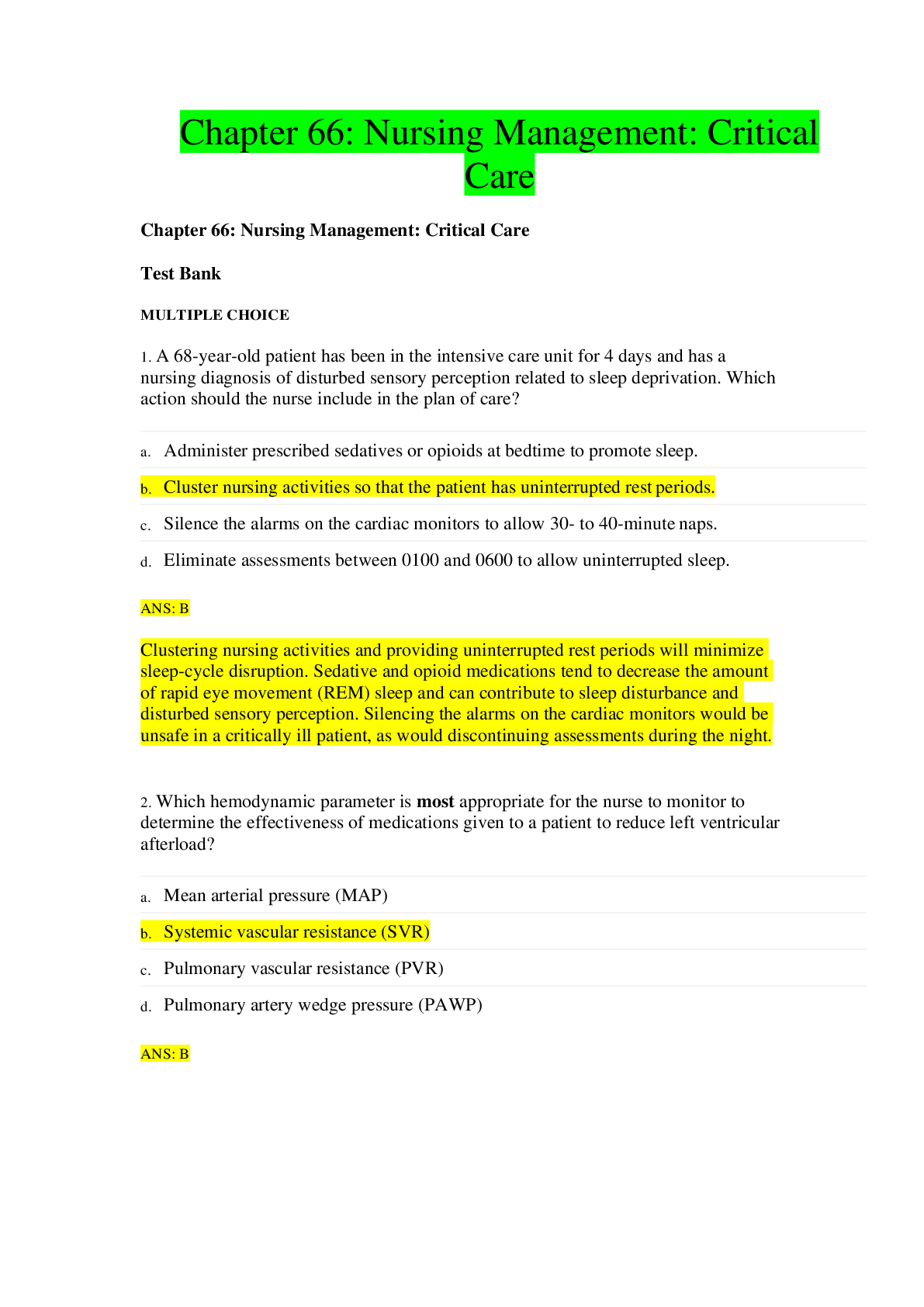
Buy this document to get the full access instantly
Instant Download Access after purchase
Buy NowInstant download
We Accept:

Reviews( 0 )
$8.00
Can't find what you want? Try our AI powered Search
Document information
Connected school, study & course
About the document
Uploaded On
Apr 22, 2020
Number of pages
18
Written in
Additional information
This document has been written for:
Uploaded
Apr 22, 2020
Downloads
0
Views
102

